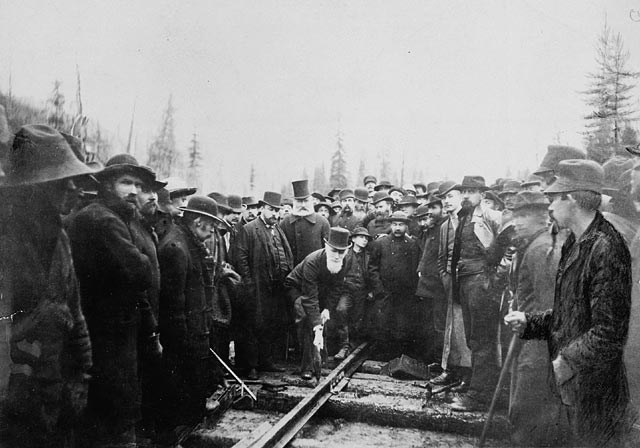Canadian Pacific Railway
The Canadian Pacific Railway company was incorporated in 1881. Less than five years later the transcontinental line from Montreal to Port Moody, a distance of 2,893 miles, was completed (Eagle, 3). Its original purpose was in the construction of a transcontinental railway, to fulfill a promise made to British Columbia upon its entry into Confederation in 1871. On November 7th, 1885, company director Donald Smith drove the last spike among the mountains of British Columbia, marking the completion of the Canadian Pacific Railway (Woodcock, 47). It was completed in less than half the time it was originally contracted for; and the feat of building this three-thousand-mile railroad over difficult terrain in less than five years can be largely attributed to William Cornelius Van Home, the first General Manager of the Canadian Pacific (Woodcock, 54). The creation of the CPR provided Canada with a transportation infrastructure necessary for its western ambitions and allowed the country to make use of the land it had acquired. Its completion in 1885 “marked an important stage in the process by which Canada changed from a loose group of scattered colonies, divided by a great waste of prairie and mountains inhabited only by Indians and fur traders, into the nation it is today” (Woodcock, 48). The CPR soon became the country’s most successful narrative and played an important role in the development of the nation by connecting the Canadian territory from east to west and unifying the dominion in its path.
In order for the railway to be profitable, the CPR needed more passengers and cargo, however few people inhabited the Canadian west at that time. The CPR operated mostly in the wilderness and the usefulness of the prairies was considered to have great potential for the newly formed Dominion of Canada. As early as 1881, Canadian Pacific got involved in land settlement and land sales. Under the initial contract with the Canadian Government to build the railway, the CPR was granted 25,000,000 acres of land and the Canadian Pacific began an intense campaign to bring immigrants to Canada. Canadian Pacific advertised land for settlers in Eastern Canada and the United States, and placed advertisements in European newspapers describing the fertile land of the Canadian Prairies. In 1909, Canadian Pacific spent more money promoting immigration than the Canadian government (Eagle).
The CPR represented the long-awaited liberation of the Canadian West; however, it was a privately-owned corporation as well as a national dream and its profits benefited the Canadian Pacific Railway company, not the nation as a whole (Friesen, 8). Its power in western Canada was immense and without competition, Canadian Pacific was a monopoly. However, as more people continued to head west, settlements sprang up overnight and there soon developed both a need for more transportation and a break in the monopoly and power of the Canadian Pacific Railway Company (Lowe, 53). In 1904, the passage of the Transcontinental Railway Bill through the Parliament of Canada became one of the most significant legislative acts for the Dominion of Canada (MacKenzie King, 136). It represented the movement away from the privately owned Canadian Pacific Railway Corporation and the need for more security and independence in regard to the industrial and commercial expansion of Canada.
 Photo Credit: The Last Spike
Photo Credit: The Last Spike
Bibliography:
Friesen, Gerald, A. 1984. "Preparing for Western Settlement, 1870-1890." Journal of The West 23, no. 4: 5-10.
Lowe, Norman, J. 1978. "Canada's Third Transcontinental Railway: The Grand Trunk Pacific/National Transcontinental Railways." Journal of The West 17, no. 4: 52-61.
Regehr, T. D. The Canadian Northern Railway: Pioneer Road of the Northern Prairies, 1895–1918. Toronto: Macmillan. 1976.
W. L. MacKenzie King. "The National Transcontinental Railway of Canada." The Quarterly Journal of Economics 19, no. 1 (1904): 136-48. http://www.jstor.org/stable/1884867.
Woodcock, George. 1958. "The Canadian Pacific Railway." History Today 8, no. 1: 47-55.

 Photo Credit:
Photo Credit: